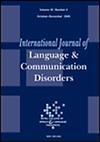Evaluating a Targeted Language Intervention for Children Aged 4–6 Years—Applying an ‘Information Carrying Words’ Approach
Abstract
Background
Very little research has investigated the use of the information carrying words (ICW) construct within language interventions, despite its very widespread use in speech and language therapy in the United Kingdom. The Language Enrichment Activity Programme (LEAP) is an intervention programme that applies the ICW construct to differentiate children's level of need and structure play-based learning activities. LEAP sessions are designed to be child-led, building language skills through application of communication supporting strategies (CSS) such as modelling, recasting and inviting communicative participation via choices and expectant pausing.
Aims
This study aims to evaluate the impact of trainee speech and language therapists (SLTs) delivering LEAP on the language skills of primary school children (aged 4–6 years).
Methods and Procedures
One hundred eighteen children were selected by their teachers. Participating children were semi-randomly allocated to either a control group (n = 48) or to a group that received 12 sessions of LEAP over 6 weeks (n = 70). A smaller sub-cohort was followed up 8 weeks following the end of LEAP (received LEAP n = 41, control group n = 46). LEAP was delivered by trainee SLTs to small groups of children. Assessments were carried out blind to group allocation pre- and post-intervention in order to evaluate the impact of intervention on receptive and expressive language skills. Outcome measures were a bespoke comprehension and expression outcome measure and the Renfrew Action Picture Test (RAPT; Renfrew 2019).
Results
Children who received LEAP had improved scores on both the RAPT assessment and the bespoke outcome measure. There was a significant interaction between time (pre- and post-intervention) and group (those who received LEAP vs. the control) for the RAPT grammar score, and the LEAP vocabulary and expressive ICW score. LEAP had less of an impact for a sub-cohort followed up 8 weeks following the intervention, with only the LEAP expressive score showing significant interaction between the three assessment time points and group (those who received LEAP vs. the control).
Conclusions and Implications
The LEAP was successfully delivered to small groups of children and supported them in developing their expressive language skills. Working with trainee SLTs increased the capacity to deliver LEAP at a low cost to schools. Results are promising and add to an emerging evidence base for the application of the ICW construct within SLT intervention programmes.
WHAT THIS PAPER ADDS
- Use of an information carrying words (ICW) construct in speech and language therapy is very common in the United Kingdom, and yet very little research has been done in this area. There is strong evidence for the role of communication supporting strategies (e.g., recasting, giving choices, and use of multisensory input) to accelerate children's language development. However, more translational research is needed to investigate the impact of interventions which include such strategies. New service delivery models are also needed to facilitate increased access to interventions, particularly beyond the preschool years and where schools are unable to staff comprehensive language interventions internally.
- This project evaluates the impact of a targeted language intervention programme for children in the early stages of primary school in the United Kingdom: the Language Enrichment Activities Programme (LEAP). This programme uses ICW to differentiate language intervention activities, while using robust communication supporting strategies during sessions. The study evaluates the impact of LEAP on a cohort of 118 children from 8 schools, with promising results. Children who received LEAP had increased scores on measures of expressive language when compared to children who did not take part in LEAP.
- Our study adds to an emerging evidence base supporting the application of the ICW construct within language interventions. It also offers a model for collaboration between schools, speech and language therapy services, and trainee speech and language therapists to increase capacity for targeted small group interventions for language skills in early primary school. The paper uses the LEAP intervention as a starting point for discussion about how to best deliver targeted small group interventions and issues in making these types of groups inclusive and accessible.

 求助内容:
求助内容: 应助结果提醒方式:
应助结果提醒方式:


